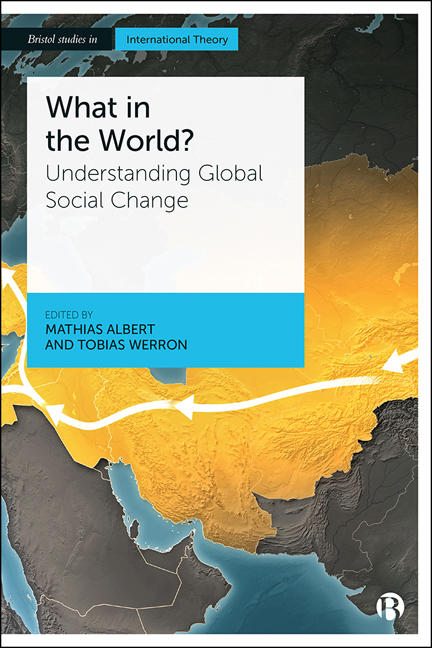Book contents
- Frontmatter
- Contents
- List of Figures and Tables
- Notes on Contributors
- Acknowledgements
- 1 Introduction: World Society and Its Histories – The Sociology and Global History of Global Social Change
- 2 Every Epoch, Time Frame or Date that Is Solid Melts into Air. Does It? The Entanglements of Global History and World Society
- 3 Periodization in Global History: The Productive Power of Comparing
- 4 Communication, Differentiation and the Evolution of World Society
- 5 Field Theory and Global Transformations in the Long Twentieth Century
- 6 Organization(s) of the World
- 7 Particularly Universal Encounters: Ethnographic Explorations into a Laboratory of World Society
- 8 From the First Sino-Roman War (That Never Happened) to Modern International-cum-Imperial Relations: Observing International Politics from an Evolution Theory Perspective
- 9 Nationalism as a Global Institution: A Historical-Sociological View
- 10 States and Markets: A Global Historical Sociology of Capitalist Governance
- 11 The Impact of Communications in Global History
- 12 The ‘Long Twentieth Century’ and the Making of World Trade Law
- 13 Third-Party Actors, Transparency and Global Military Affairs
- 14 Technical Internationalism and Global Social Change: A Critical Look at the Historiography of the United Nations
- References
- Index
12 - The ‘Long Twentieth Century’ and the Making of World Trade Law
Published online by Cambridge University Press: 22 December 2021
- Frontmatter
- Contents
- List of Figures and Tables
- Notes on Contributors
- Acknowledgements
- 1 Introduction: World Society and Its Histories – The Sociology and Global History of Global Social Change
- 2 Every Epoch, Time Frame or Date that Is Solid Melts into Air. Does It? The Entanglements of Global History and World Society
- 3 Periodization in Global History: The Productive Power of Comparing
- 4 Communication, Differentiation and the Evolution of World Society
- 5 Field Theory and Global Transformations in the Long Twentieth Century
- 6 Organization(s) of the World
- 7 Particularly Universal Encounters: Ethnographic Explorations into a Laboratory of World Society
- 8 From the First Sino-Roman War (That Never Happened) to Modern International-cum-Imperial Relations: Observing International Politics from an Evolution Theory Perspective
- 9 Nationalism as a Global Institution: A Historical-Sociological View
- 10 States and Markets: A Global Historical Sociology of Capitalist Governance
- 11 The Impact of Communications in Global History
- 12 The ‘Long Twentieth Century’ and the Making of World Trade Law
- 13 Third-Party Actors, Transparency and Global Military Affairs
- 14 Technical Internationalism and Global Social Change: A Critical Look at the Historiography of the United Nations
- References
- Index
Summary
Introduction
Since the 1990s, the concept of ‘globalization’ – usually understood as the increasing economic, social and cultural integration of world regions – has become a leitmotif for popular and scholarly narratives of global social change in modernity (Eckel, 2018). The history of global economic integration is commonly narrated as forming two great ‘waves’ in the later nineteenth and later twentieth centuries, interspersed by an era of ‘deglobalization’ characterized by two world wars and the formation of autarchic economic ‘blocs’ (Chase-Dunn et al, 2000; Bordo et al, 2003). Theorists working in a Marxian worldsystems tradition have similarly associated two eras of stable capitalist globalization with the presence of strong economic and military hegemons: the British Empire in the nineteenth century and the United States in the twentieth (Arrighi, 1994).
This model of globalization as a homogeneous absolute – something that is either present or absent, rising or falling – obscures more than it reveals. As Stefan Link has argued, arguments that claim similarities between a ‘first’ and ‘second’ era of globalization – and thereby imply that our present ‘deglobalization’ will terminate in a bloody conflagration on the scale of World War II – understate the extent to which ‘different periods of globalization have relied on distinctive political and institutional architectures’. What is required is a more granular account of the ‘politics of globalization’ – one capable of appreciating the variety of ‘structured engagement’ between polities of all kinds and ‘foreign trade and capital’ (Link, 2018: 347).
States and markets, George Lawson tells us in the present volume, have been mutually constituted. The broadening and deepening of global economic integration has been enabled by state action, just as states have been empowered – and constrained – by the expansion of markets to a global scale. Drawing on Chapter 5 by Julian Go, we might further observe that the structure of the global political field was transformed by decolonization after the mid-twentieth century. The ‘reglobalization’ of the world economy after 1945 occurred in connection with the elaboration of an international, as opposed to an inter-imperial, understanding of a legitimate global order. Taking the mutual constitution of states and markets seriously must mean, therefore, that we examine the interactions between the basic structures of the international system and those of the global economy.
- Type
- Chapter
- Information
- What in the World?Understanding Global Social Change, pp. 211 - 226Publisher: Bristol University PressPrint publication year: 2020



